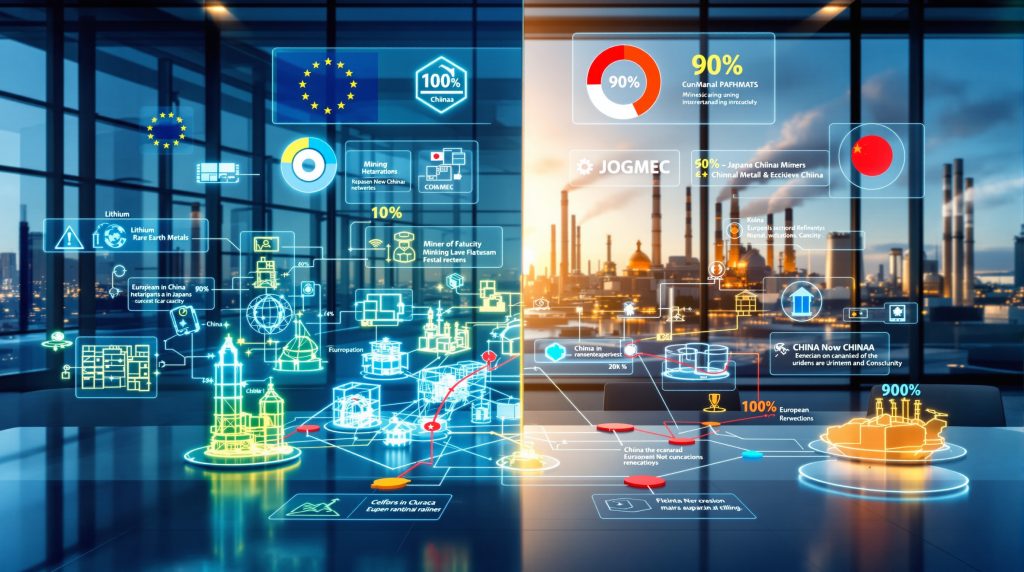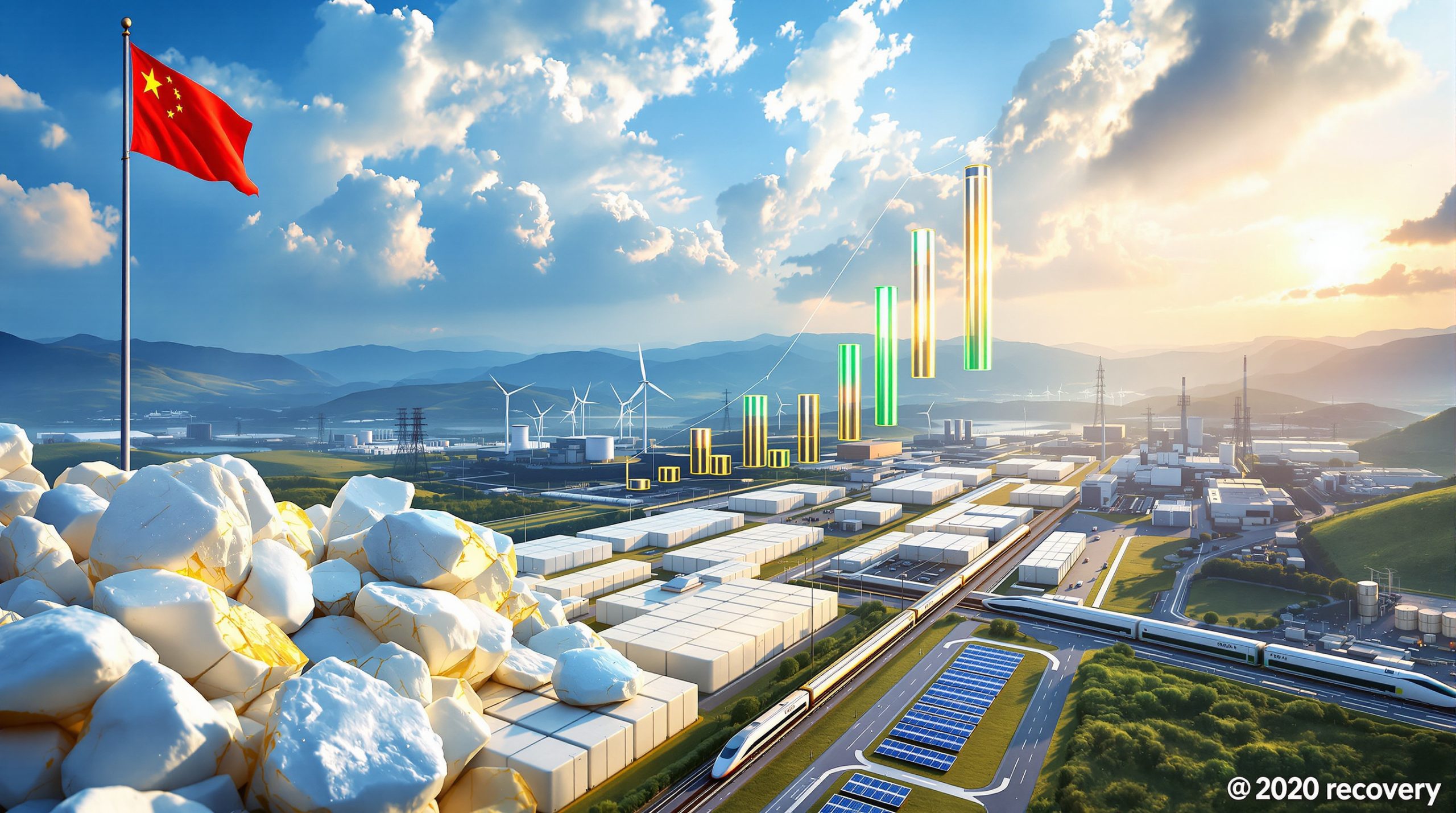Understanding Europe's Critical Minerals Challenge
Europe confronts a strategic vulnerability that could undermine its industrial competitiveness and geopolitical autonomy for decades. The continent's dependence on external suppliers for critical raw materials has reached alarming levels, with China controlling vast segments of the global supply chain from extraction to processing. This dependency encompasses essential materials including lithium, cobalt, rare earth elements, and gallium that form the backbone of Europe's critical minerals energy transition and defense capabilities.
The magnitude of this challenge becomes clear when examining specific supply chain bottlenecks. According to the European Initiative for Energy Security, over 90% of global refining capacity for critical minerals remains concentrated in China, creating both pricing leverage and potential supply disruption risks for European manufacturers. This concentration extends beyond raw processing to include sophisticated value-added activities such as permanent magnet production and battery component manufacturing.
European policymakers recognise that traditional market mechanisms alone cannot address these structural vulnerabilities. The continent requires a fundamentally different approach to resource security, one that combines strategic planning, financial backing, and long-term partnerships. This realisation has sparked interest in developing a European JOGMEC equivalent that could provide the institutional framework necessary for effective competition in global critical minerals markets.
What Is JOGMEC and How Does It Work?
Japan Organization for Metals and Energy Security operates as a comprehensive state-backed agency designed to secure Japan's access to critical materials through strategic investments and partnerships. Established in 2004 following Japan's recognition of its resource vulnerability, JOGMEC has evolved into a sophisticated financing and risk management institution that bridges government strategy and private sector execution.
The agency's operational model combines multiple functions within a single organisational structure:
• Direct equity investments in overseas mining and processing projects
• Risk-sharing partnerships with Japanese companies seeking to develop resource assets
• Strategic stockpiling programmes for materials deemed critical to national security
• Technology development initiatives focused on extraction, processing, and recycling innovations
• Intelligence gathering and analysis of global supply chain vulnerabilities and opportunities
JOGMEC's financial structure provides flexibility that traditional commercial lenders cannot match. The agency can accept higher risk profiles and longer payback periods than private investors, particularly for early-stage exploration and development projects in challenging jurisdictions. This capability has enabled Japan to secure meaningful stakes in resource projects across Africa, Latin America, and Asia while supporting domestic companies' international expansion.
The agency's success stems from its integration of commercial and strategic objectives. Unlike pure development finance institutions, JOGMEC operates with explicit national security mandates that allow it to pursue projects based on strategic value rather than purely commercial returns. This approach has proven particularly effective in securing access to materials where China's state-backed entities compete aggressively for market control.
Why Europe Lacks a JOGMEC Equivalent
Europe's approach to critical minerals security remains fragmented across national programmes and EU-level coordination mechanisms that lack the financial resources and operational agility demonstrated by JOGMEC. Current European initiatives include the Critical Raw Materials Act, various bilateral resource partnerships, and targeted funding programmes, but these fall short of creating an integrated risk-sharing architecture capable of competing with state-directed approaches.
Several structural factors limit European effectiveness in this domain:
• Bureaucratic complexity across multiple member states and EU institutions delays project approval and funding
• Limited risk tolerance among European development finance institutions for early-stage mining investments
• Insufficient coordination between defence requirements and industrial policy objectives
• Overreliance on market mechanisms rather than strategic intervention in critical supply chains
• Fragmented decision-making processes that prevent rapid response to emerging opportunities or threats
The European Investment Bank and various national development banks provide some project financing for resource-related investments, but these institutions operate under commercial lending criteria that often exclude the higher-risk, strategic projects most critical for supply chain security. Furthermore, private European mining companies frequently find themselves outbid by Chinese state-owned enterprises that can access patient capital and accept lower returns on strategic investments.
European environmental and regulatory standards, while important for sustainable development, create additional barriers to rapid project development. Permitting processes that take several years in Europe can be completed much faster in other jurisdictions, giving competitors significant advantages in securing attractive resource assets before European entities can complete due diligence and approval processes.
The European Minerals Investment Network (E-MIN) Proposal
Recent policy analysis suggests that Europe needs a fundamentally new institutional approach to critical minerals security, centered on what researchers term the European Minerals Investment Network. This proposed framework would create a permanent coordination mechanism connecting public financiers, private investors, mining companies, and industrial end-users within a unified risk-sharing ecosystem.
E-MIN would operate through several integrated components:
• Standing coordination forum enabling rapid decision-making on strategic investment opportunities
• Direct access to EU budget allocations including green transition funds, defence spending, and competitiveness initiatives
• Authority to negotiate long-term offtake agreements on behalf of European industrial consumers
• Capability to establish and manage strategic stockpiles of critical materials
• Integration with NATO defence planning to ensure alignment with security requirements
The network concept recognises that Europe's federal structure requires different institutional solutions than Japan's centralised approach. Rather than creating a single agency, E-MIN would leverage existing institutions while providing new coordination mechanisms and funding authorities that enable more aggressive and strategic intervention in global markets.
Implementation would require significant changes to current EU treaty arrangements and budget allocation processes. Member states would need to delegate certain sovereign authorities over resource policy to EU-level institutions, while also committing to substantial financial contributions for strategic stockpiling and investment programmes.
How Would a European JOGMEC Address Supply Chain Vulnerabilities?
A European critical minerals agency would target specific chokepoints where concentrated market control creates maximum vulnerability for European industries. The refining and processing bottleneck represents the most critical weakness, where China's dominance enables both pricing manipulation and potential supply disruption despite Europe's substantial engineering capabilities and domestic mineral deposits.
Strategic intervention would focus on several key areas:
| Intervention Type | Target Outcome | Investment Priority |
|---|---|---|
| Midstream Processing | Reduce 90% Chinese refining dependency | $600 billion by 2050 |
| Strategic Stockpiling | 6-month supply buffer for critical materials | $300 billion total |
| Technology Development | Next-generation extraction and recycling | $150 billion R&D |
| Downstream Integration | Secure end-user supply chains | $400 billion manufacturing |
The agency would use anchor offtake contracts with major European automotive manufacturers like Volkswagen, Stellantis, and BMW to provide guaranteed revenue streams for new processing facilities. These agreements would offer price premiums above spot market rates in exchange for supply security and environmental standards compliance.
Emergency stockpiling programmes would maintain strategic reserves of materials with high supply risk profiles, particularly heavy rare earth elements and processing chemicals required for advanced manufacturing. Unlike commercial inventories, these stockpiles would be managed for strategic rather than economic optimisation, with release triggered by supply disruptions or price manipulation events.
Technology development initiatives would accelerate deployment of alternative processing methods that reduce dependency on Chinese-controlled techniques and equipment. This includes hydrometallurgical processes, direct lithium extraction, and advanced recycling technologies that can recover critical materials from end-of-life products with higher efficiency than current methods.
What Are the Key Investment Priorities?
The most urgent priority involves establishing a CRM facility in Europe that can process key materials domestically rather than shipping raw materials to China for refinement and re-importing finished products. This approach would capture value-added processing while reducing supply chain risks.
EU-Japan Cooperation on Critical Materials
The July 2023 Administrative Arrangement between the European Commission and JOGMEC establishes a framework for enhanced cooperation on critical materials security, recognising shared vulnerabilities and complementary capabilities between the two regions. This collaborative agreement creates formal mechanisms for information sharing, joint risk assessment, and coordinated responses to supply chain disruptions.
Key cooperation areas include:
• Intelligence sharing on market manipulation attempts and artificial pricing pressures
• Joint technology development for recycling, alternative materials, and processing innovations
• Coordinated investment strategies to avoid bidding competition between European and Japanese entities
• Best practices exchange on government-industry partnership models and risk management
• Emergency response protocols for coordinated action during supply crises
This partnership demonstrates growing recognition that resource security requires coordinated action among allied nations rather than competitive approaches that benefit dominant suppliers. Japan's experience with Chinese export restrictions on rare earth elements in 2010 provides valuable lessons for European policymakers developing their own response capabilities.
The arrangement also facilitates joint investment in third-country projects, enabling European and Japanese entities to combine resources and expertise for large-scale development initiatives. This cooperation model could extend to other allied nations, creating broader coalitions for strategic resource security that compete more effectively against state-directed approaches.
Financial Requirements for European Resource Independence
Achieving meaningful supply chain independence requires massive capital deployment across the entire critical minerals value chain. Industry analysis suggests Europe will need approximately $2.1 trillion in new mineral-related investments by 2050 to reduce dependency on potentially unreliable suppliers and build resilient domestic capacity.
This investment requirement breaks down across several categories:
• Mining development and exploration: $800 billion for new deposits and expansion projects
• Refining and processing capacity: $600 billion for midstream facilities and technology
• Recycling infrastructure: $400 billion for collection, processing, and remanufacturing systems
• Strategic stockpiles and reserves: $300 billion for emergency supply buffers
Current European funding mechanisms fall dramatically short of these requirements. The EU's Green Deal Industrial Plan allocates approximately $270 billion for clean technology deployment, but only a fraction targets critical minerals specifically. National development banks and the European Investment Bank provide additional resources, but their combined capacity represents less than 20% of identified investment needs.
The financing gap becomes particularly acute for higher-risk, early-stage projects where commercial lenders demand returns that make strategic investments uneconomical. However, a European JOGMEC would need authority to accept lower returns and longer payback periods, similar to development finance approaches used for infrastructure and energy security projects.
Private sector mobilisation remains essential but requires public sector risk-sharing to achieve necessary scale. Blended finance mechanisms that combine public guarantees with private capital could multiply available resources while maintaining commercial discipline in project selection and management.
Integration with Defence and Security Policy
European resource security strategy must integrate critical minerals policy with defence planning, recognising that material access represents a fundamental component of national security capability. This integration involves NATO coordination, defence budget allocation, and strategic planning that treats minerals as military assets rather than purely commercial commodities.
Defence integration encompasses several critical elements:
• Weapons systems requirements for advanced alloys, rare earth magnets, and specialised materials
• Defence contractor supply chain resilience through domestic sourcing preferences and stockpiling
• Emergency allocation protocols during conflicts or major supply disruptions
• Dual-use technology development that serves both civilian and military applications
• Allied coordination on strategic stockpiling and mutual support agreements
Modern defence systems require substantial quantities of critical materials that often have limited alternative suppliers. F-35 fighter aircraft contain over 400 pounds of rare earth materials per unit, while advanced missile guidance systems depend on specialised semiconductors and magnetic components with highly concentrated supply chains.
European defence spending, which has increased significantly following Russia's invasion of Ukraine, provides a potential funding source for strategic minerals initiatives. Defence budgets traditionally accept higher costs and lower commercial returns when justified by security requirements, making them suitable for underwriting strategic stockpiling and domestic capacity development programmes.
NATO's new Strategic Concept recognises supply chain security as a collective defence issue, creating frameworks for coordinated resource planning among alliance members. This approach could facilitate burden-sharing arrangements where different nations specialise in specific materials or processing capabilities while maintaining mutual access through formal agreements.
Regulatory and Environmental Considerations
European environmental regulations and permitting processes create significant barriers to domestic mining and processing development, often requiring 5-7 years for major project approvals compared to 2-3 years in competing jurisdictions. A European critical minerals agency would need authority to streamline approvals for strategic projects while maintaining environmental standards through advanced technology deployment and best practices implementation.
Regulatory reform priorities include:
• Fast-track permitting procedures for projects designated as critical to European security
• Standardised environmental impact assessments across member states to reduce regulatory uncertainty
• Technology standards that incentivise sustainable extraction and processing methods
• Waste management protocols for processing facilities and recycling operations
• Community engagement requirements that ensure local acceptance and benefit-sharing
The European Green Deal's emphasis on environmental protection need not conflict with resource security objectives if properly implemented. Advanced mining and processing technologies can achieve environmental performance superior to global averages while reducing Europe's dependence on suppliers with lower environmental standards.
Circular economy principles offer significant potential for reducing primary resource requirements through improved recycling and remanufacturing. Current European recycling rates for critical materials remain below 5% for most elements, suggesting substantial room for improvement through targeted investment and regulatory incentives.
Environmental standards can also provide competitive advantages by ensuring that European-produced materials meet increasingly stringent supply chain sustainability requirements from major industrial consumers. Automotive manufacturers and electronics companies face growing pressure to demonstrate responsible sourcing throughout their supply chains.
How Do Regional Resources Factor Into Strategy?
The broader critical minerals landscape includes resources from regions like Greenland's critical minerals deposits, which could provide alternative supply sources for European JOGMEC operations. Such regional partnerships would reduce dependency on distant suppliers while supporting allied nations' economic development.
Timeline and Implementation Challenges
Creating a European JOGMEC equivalent requires fundamental changes to EU institutional structures, member state sovereignty arrangements, and budget allocation mechanisms. The complexity of European decision-making processes suggests implementation would require 5-10 years even with strong political commitment and streamlined procedures.
Implementation would proceed through several phases:
Phase 1: Policy Framework Development (Years 1-2)
• Treaty modifications to enable enhanced EU competencies
• Institutional design and governance structure establishment
• Initial funding mechanism development and legal frameworks
Phase 2: Funding Integration and Capacity Building (Years 2-4)
• EU budget integration across multiple spending categories
• Staff recruitment and operational capability development
• Initial project pipeline development and partner identification
Phase 3: Operational Launch and Pilot Projects (Years 4-6)
• First strategic investments and partnership agreements
• Stockpiling programme initiation and facility development
• Technology development programme launch and coordination
Phase 4: Full Operational Capacity (Years 6-10)
• Comprehensive programme implementation across all target materials
• Integration with defence planning and NATO coordination
• Performance evaluation and programme refinement
Political obstacles include member state reluctance to delegate additional sovereignty to EU institutions, particularly in areas traditionally considered national security prerogatives. Budget allocation challenges involve securing sufficient resources from competing priorities while maintaining fiscal discipline requirements under EU treaties.
Operational complexity increases with the number of participating institutions and jurisdictions. Coordination between national development banks, EU institutions, private investors, and industrial partners requires sophisticated governance mechanisms and clear decision-making authorities to avoid bureaucratic paralysis.
Competitive Response to Chinese Dominance
China's vertical integration across critical minerals value chains creates both pricing power and supply security risks that require coordinated European response strategies. Chinese state-owned enterprises benefit from patient capital, government subsidies, and integration with domestic industrial consumers that enable aggressive bidding for strategic resource assets worldwide.
European competitive strategies must address several dimensions:
• Counter-financing capabilities that can match Chinese investment terms for strategic projects
• Technology partnerships that bypass Chinese-controlled processing and manufacturing stages
• Alternative supply chain development in allied and partner nations
• Market intelligence systems to anticipate and counter Chinese strategic moves
• Coordinated purchasing programmes to influence global pricing and supply allocation
The scale of required competition is substantial. Chinese entities invested over $15 billion in overseas mining projects during 2023, while European investment in similar projects totalled less than $3 billion. This investment gap translates directly into supply chain control and pricing influence that disadvantages European industrial consumers.
Technology competition offers more promising avenues for European advantage. European engineering capabilities in processing, automation, and environmental management could provide competitive advantages if supported by appropriate financing and market access. Next-generation extraction and processing technologies developed in Europe could reduce Chinese technological dependencies while improving cost and environmental performance.
Strategic partnerships with resource-rich nations in Africa, Latin America, and Australia could provide alternative supply sources while supporting development objectives in partner countries. These partnerships require long-term commitment and patient capital that align with recipient nations' development priorities rather than purely extractive approaches.
Long-term Strategic Implications
The success or failure of European efforts to develop strategic resource security capabilities will determine whether Europe maintains industrial competitiveness in critical sectors including automotive manufacturing, renewable energy, and defence technology. Without secure access to critical materials, European manufacturers face permanent disadvantages against competitors with guaranteed supply access.
The urgency of this challenge has intensified as geopolitical tensions demonstrate the weaponisation potential of resource dependencies. Recent export restrictions and pricing pressures in critical materials markets provide clear evidence that supply chain control represents a form of economic leverage that can be deployed against strategic competitors.
Industrial transformation toward electrification and digitalisation increases rather than decreases European vulnerability to supply disruptions. Electric vehicles require 5-6 times more critical materials per unit than conventional vehicles, while renewable energy systems and digital infrastructure demand substantial quantities of materials with highly concentrated supply chains.
A European JOGMEC represents more than an economic necessity. It constitutes a geopolitical imperative for maintaining European sovereignty and strategic autonomy in an increasingly multipolar world where resource access determines industrial capability and political influence.
Consequently, developing an effective critical minerals strategy becomes essential for Europe's long-term competitiveness and security. The window for effective action may be narrowing as China continues consolidating control over critical supply chains while other nations develop their own strategic resource agencies. European delay in creating effective institutional responses risks permanent disadvantage in competition for the materials that will define economic leadership in the coming decades.
Disclaimer: This analysis is based on publicly available policy reports and industry research. Investment decisions should consider multiple factors including regulatory changes, market conditions, and geopolitical developments that may affect resource security strategies and their implementation timelines.
Looking to Capitalise on Critical Minerals Market Opportunities?
Discovery Alert's proprietary Discovery IQ model delivers real-time alerts on significant critical minerals discoveries across the ASX, instantly empowering subscribers to identify actionable opportunities ahead of the broader market. Understand why major mineral discoveries can lead to substantial market returns by exploring Discovery Alert's dedicated discoveries page, showcasing historic examples of exceptional outcomes, and begin your 30-day free trial today to position yourself ahead of the market.




